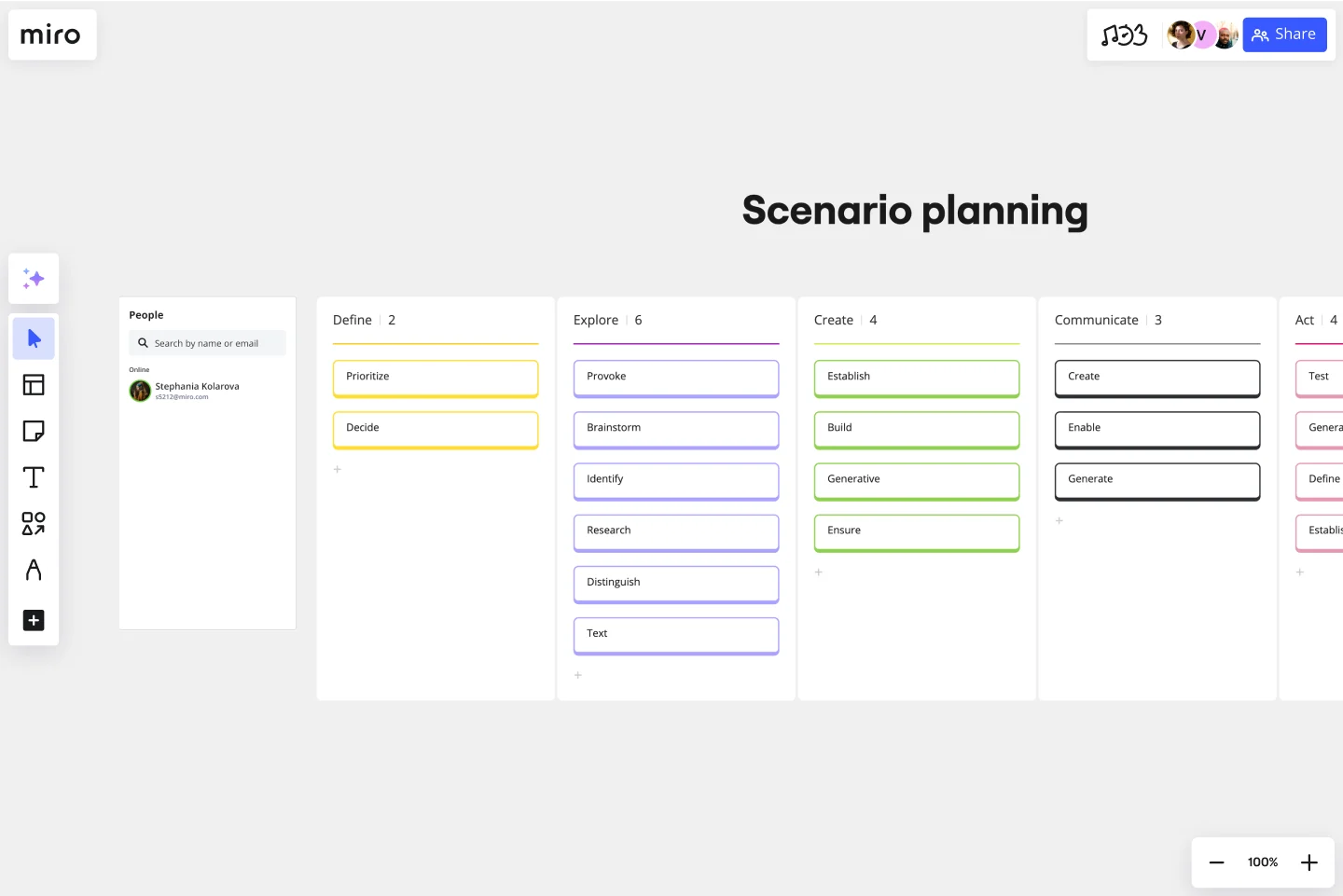Scenario Planning Template
Strategize and see different future scenarios with the scenario planning template. Bring structured thinking to teams and effectively navigate projects.
About the Scenario Planning Template
Use the scenario planning template to streamline your strategizing and ideation processes. Built with clarity in mind, this template brings a structured approach to planning, helping teams and project members navigate the complexities of project planning and execution.
The scenario planning template is a systematic framework to guide people and teams through the process of exploring, creating, communicating, and acting on different future scenarios. The template includes sections to guide you through the entire scenario planning process:
Define: This is the foundation. Here, you'll prioritize and decide on the significant factors and uncertainties impacting your scenarios.
Explore: A space to provoke thought, brainstorm ideas, identify key elements, research, distinguish between different scenarios, and test your assumptions.
Create: Dive into the core of your scenarios. Establish your ground rules, build on your ideas, use generative thinking, and ensure all details are considered.
Communicate: This area focuses on conveying your scenarios to stakeholders, from creating visual aids to enabling understanding and generating feedback.
Act: The final step involves putting your scenarios into play. Test, generate actionable tasks, define responsibilities, and establish a clear course of action.
How to use the scenario planning template in Miro
1. Customize the template: Add the template to a new board, or to an existing one where your project is being scoped. With just a few clicks, easily edit, expand, or change the template sections per your project needs.
2. Add artifacts: Seamlessly integrate artifacts like images, charts, or notes onto the Miro board, enriching your planning process.
3. Collaborate: Invite team members to join the board and collaborate in real time.
4. Save and share: Once done, save your board and share it with relevant stakeholders.
Why use a scenario planning template?
Scenario planning is a useful exercise for envisioning different plausible futures and their potential impacts on a projects goals, operations, and strategies. Using the scenario planning template to guide this process adds structure and clarity to the exercise. Here are just a few benefits to using the template:
Structured thinking: The template provides a logical flow of information, helping to organize thoughts and ideas systematically.
Flexibility: The template is customizable and can cater to various needs, making it suited for a range of projects, from business strategy to creative ventures.
Enhanced collaboration: Designed for teams, it fosters a collaborative environment, promoting shared decision-making.
Efficiency: Filling out the scenario planning template reduces the time to strategize by offering a ready-to-use framework.
Clarity: With clearly demarcated sections, all aspects of scenario planning are covered, reducing the chances of oversight.
Can I customize the template for my specific needs?
Absolutely! The template is fully editable and can be tailored to fit any project requirements.
How many people can collaborate on the template at once?
There's no set limit. Large or small teams can simultaneously collaborate and input their ideas.
Can I use the template for non-business scenarios?
Yes, the scenario planning template is versatile. It can be used in various settings, including creative projects, academic planning, and more.
Get started with this template right now.
PI Planning Template
Works best for:
PI Planning, Product Management
The Miro PI Planning Template streamlines the Program Increment planning process for Agile teams. It facilitates a collaborative environment, enabling teams to efficiently align on strategies, identify dependencies, and convert decisions into actionable tasks. With features like real-time collaboration, Jira integration, and a centralized workspace, the template supports teams in enhancing efficiency, engagement, and decision-making.
Sprint Planning with Jira Template
Works best for:
Sprint Planning, Agile
The Sprint Planning with Jira template in Miro is a powerful tool designed to streamline and enhance your sprint planning sessions. One of the key benefits of this template is its Jira integration, which saves time and effort when planning and aligning teams. By integrating directly with Jira, the template allows for seamless import and management of tasks, ensuring that all your Jira tickets are up-to-date and easily accessible within Miro. This reduces the need for manual updates and minimizes errors, making the planning process more efficient and effective.
Communication Roadmap
Works best for:
Roadmap, Mapping, Planning
The Communication Roadmap template enables teams to plan and execute effective communication strategies. By outlining key messages, channels, and stakeholders, teams can ensure consistent and targeted communication throughout a project lifecycle. This template fosters alignment and transparency, enabling teams to engage stakeholders effectively and mitigate risks associated with miscommunication.
Product Management - Product Flow
Works best for:
Product Management, Planning
Product Management - Product Flow template enables product managers to visualize and streamline product development processes. By mapping out key stages, tasks, and dependencies, this template enhances workflow transparency and coordination. With features for identifying bottlenecks and optimizing resource allocation, it empowers teams to improve efficiency and accelerate product delivery. This template serves as a valuable tool for ensuring smooth product development and launch processes, ultimately driving better outcomes.
Vision Board Template
Works best for:
Strategy & Planning, Product Development
Miro's Vision Board Template helps teams to bring their vision to life. From visual representation to real time collaboration, this template facilitates planning, execution, and achievement of any project's goals.
